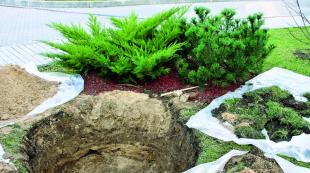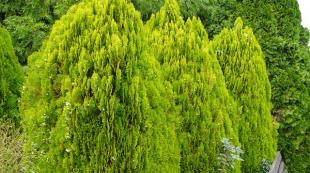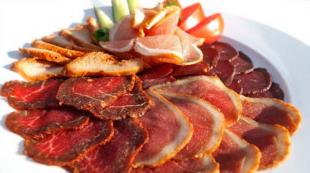What is the drink Belovezhskaya Pushcha. Zubrovka tincture: recipes and useful properties
Belovezhskaya tincture is a kind of alcoholic drink produced on the territory of Belarus in the famous reserve called Belovezhskaya Pushcha (hence the name). Today, the reserve is the only place where the original tincture is made, which has a sharp aftertaste, slight bitterness, a stunning fragrant palette and a noble brownish tint. Now the alcoholic drink in question has many admirers both in Belarus itself and in other countries of the post-Soviet space.
Product history
It's hard to believe, but the modern Belovezhskaya tincture originated from ordinary moonshine, which was made by the foresters of Belovezhskaya Pushcha in the post-war years. At that time, the quality of the produced moonshine was very low, because. the foresters did not have special equipment for cleaning. The then product had a bad taste and even frightened off guests with an unpleasant smell.
Since the Belarusian alcohol producers did not manage to acquire cleaning devices, they came up with another way to eliminate the flaws. Moonshine began to insist on fragrant herbs growing on the territory of the reserve. The plants used made the drink fragrant, and its taste qualities improved several times.
Belovezhskaya tincture owes its popularity to Nikita Sergeevich Khrushchev. Once the First Secretary of the CPSU visited Belovezhskaya Pushcha to go hunting. During the rest, the woman who was in charge of regaling the high-ranking guest brought Khrushchev a tincture made by the foresters. The taste of the drink impressed the First Secretary so much that a few days later food specialists arrived at the woman. They wrote down the recipe for the tincture in detail, and soon mass production of this product was established.
Today, this drink is served only in restaurants located near the reserve. However, connoisseurs of quality alcohol do not need to travel to Belarus to enjoy its taste. Such a product can be ordered online or cooked at home.
How to make tincture at home?
The algorithm for preparing Belovezhskaya tincture cannot be called too complicated, but it will take a lot of time to get the finished product.
To make 10 liters of drink, you will need to take:
- dubrovka rhizomes - 16 g;
- dill seeds - 12 g;
- bay leaf - about 10 g;
- sugar - 20 g;
- burnt sugar - 2 g.
At the very beginning, you need to make 3 different tinctures. To do this, pour the indicated number of dubrovka rhizomes, dill seeds and bay leaves into 3 separate half-liter containers. After that, fill the containers with 60 percent moonshine. Then tightly cork them and transfer to a dark place for 28-30 days. During the infusion period, containers with liquids must be shaken daily.
Further actions:
- Pour 40% moonshine into a liter container (in the absence of such, you can use stronger alcohol, but it must be diluted with water).
- In a container with moonshine, add 60 ml of tincture from the rhizomes of oak, about 50 ml of dill tincture and 10 ml of tincture of bay leaf;
then pour the indicated amount of sugar into the container; prepare burnt sugar and pour 2 g of this ingredient. - We tightly cork the dishes and transfer it to a dark place.
We insist the liquid for a month (as in the case of 3 independent tinctures, you will need to shake the dishes with the mixture daily). - After the time has elapsed, we filter the drink and pour it into a clean storage container (keep finished product recommended in cellars or other cool places).
If all the steps were correct, you will get an excellent alcoholic drink that will become a real decoration of the festive table. Even if after the first attempt the quality of the tincture is far from ideal, do not despair. After a certain number of samples, you will definitely become the owner of an amazing drink.
When making a tincture, it is important to consider some points. First of all, only moonshine made from natural products should be used as an alcohol base. The use of store-bought vodka is undesirable, because. it may contain preservatives that can adversely affect the taste and aroma of the tincture. Of course, you can spend money on an expensive brand of vodka, but then preparing a drink will require significant material costs. As for alcohol, such a base will be too strong. And even if it is diluted, there is no guarantee that the tincture will not turn out to be very bitter.
Moonshine must also meet certain criteria. The main requirement is the absence of any aftertaste. The fact is that when combined with aromatic independent tinctures, a mixture of tastes can occur, and this can harm the taste palette of the finished drink.
Precautionary measures
Since Belovezhskaya tincture is an alcoholic drink, it has certain contraindications. It must be abandoned if:
- diseases of cardio-vascular system, pancreas, liver;
- alcoholism;
- alcohol intolerance.
When using tincture, you must always follow the norm, otherwise you may develop alcohol dependence. In addition, excessive consumption of the drink can cause poisoning.
Zubrovka is a real legendary vodka, with ancient history and a mass of admirers throughout the post-Soviet space and beyond. Meanwhile, there is nothing easier than repeating the famous bison recipe at home - this is probably the simplest of the bitters.
The word "Zubrovka" is probably familiar to every inhabitant of the post-Soviet space. This unique vodka with a light herbal aroma and an original golden-green color has been a regular since Soviet times. holiday tables most different people: from simple hard workers to general secretaries of the Central Committee. Leonid Ilyich himself was very fond of this drink and used it, according to his own statement, “tits-masiski”.
Meanwhile, there is nothing easier than repeating the famous bison recipe at home - this is probably the simplest of the bitters. Today we will talk about interesting history legendary vodka, let's find out the simplest recipe bison from moonshine, alcohol or vodka, and also - we will try to reproduce the recipe for the original Zubrovka Zlata tincture with prunes, galangal, cinnamon and oak bark!
The special vodka "Zubrovka" has been known for a long time - it has been produced in Belarus and Poland for more than 500 years, since the 16th century. The Commonwealth was a well-known center for distilling, many different drinks were produced here, which were traded throughout Europe, take at least the same Starka, “Slavic whiskey”. But the rich tycoons dabbled in starka, mostly. Ordinary people preferred Zubrovka - at home it is done quickly, it requires few ingredients, and it tastes much better than ordinary, even well-purified moonshine.

The main element of the tincture is "Scented bison", Hierochloë odorata. The famous Belovezhskaya Pushcha is considered the birthplace of this fragrant herb - almost the only island of prehistoric forest in Europe that once covered the entire mainland. Majestic bison lived for themselves, nibbling green treats, but a man came, let the weed into the production of tincture, and the bison themselves - for a snack. Now these animals are protected by the state, and Hierochloë odorata is cultivated in Belarus, Lithuania, Ukraine and Poland.
The commercial production of bison has been established since the end of the 19th century, after the abolition of the Bolshevik Prohibition, it gained wide popularity in the USSR. The aroma of fragrant stems hides the shortcomings of vodka very well, but at the same time, the drink is perfectly drunk with almost any snack.
“On this day, God sent Alexander Yakovlevich for lunch a bottle of bison, homemade mushrooms, herring mincemeat, Ukrainian borscht with 1st grade meat, chicken with rice and dried apple compote”
 Real Zubrovka vodka contains coumarin glycoside - not the most useful substance, in the USA it is even included in the list of poisonous ones. In fact, coumarin is not so dangerous - it can cause harm to the body only with prolonged use.
Real Zubrovka vodka contains coumarin glycoside - not the most useful substance, in the USA it is even included in the list of poisonous ones. In fact, coumarin is not so dangerous - it can cause harm to the body only with prolonged use.
But it also has positive aspects - this substance increases appetite, improves digestion, and besides, it is this substance that gives Zubrovka that very smell of freshly cut grass.
Connoisseurs of the unique aroma and taste of bison all over the world drink a real drink, and only Americans - alcohol "yupi" with flavors and a plastic blade of grass in a bottle - it has been produced in Poland especially for the States since 1999.
A simple recipe for Zubrovka from moonshine or vodka
Do not want to buy imported Polish vodka in the market, but would you like to make it yourself? There is nothing easier! All we need:
- Vodka or good, purified moonshine at least twice distilled. Alcohol diluted to 45% is also suitable.
- 1 tsp Sahara;
- Actually, Zubrovka Fragrant. You can buy it from grandmothers in the market or in pharmacies specializing in medicinal herbs.
According to the classic recipe for bison, 2 kg is used per ton of vodka. herbs, that is, per liter you will need only 2 grams - 1-2 blades of grass or a tablespoon in chopped form. A concentrated syrup is prepared from sugar. If you do not use vodka, but alcohol or moonshine, the sugar content should be increased to 1.5-2 teaspoons.

 We throw the grass into a jar, fill it with alcohol, add sugar syrup and send it to a dark, warm place for 2 weeks. After settling, we filter the drink through gauze and that's it, your Zubrovka tincture is ready for use!
We throw the grass into a jar, fill it with alcohol, add sugar syrup and send it to a dark, warm place for 2 weeks. After settling, we filter the drink through gauze and that's it, your Zubrovka tincture is ready for use!
There are nuances in this bison recipe. The fact is that the grass can be collected at different times of the year, stored in different ways. As a result, the content of coumarin in it may vary.
Throw too much - the drink will become bitter and green, too little - there will be no desired flavoring effect. Therefore, you can take more grass, insist it for a couple of weeks on pure 96% alcohol, and then add the concentrate little by little to vodka until you get the desired taste and color.
Complicate the task - the original vodka "Zubrovka Zlata"
Żubrówka Zlota is a new bitters produced by the Polish corporation CEDC. It has nothing in common with the classic Zubrovka - fragrant Zubrovka is not even included in the composition. But this drink is very tasty, it looks like a very good “home-made cognac”, it goes well in its pure form, with coffee, cola, and especially with uzvar (dried fruit compote).
To be honest, I did not prepare this tincture and did not find the exact recipe anywhere. But the list of ingredients is very interesting, and the branded drink is really tasty, I speak from my own experience. So I suggest that the readers of The Rum Diary experiment and unravel the Golden Zubrovka recipe at home. A general educational article on home tinctures will help us with this.
We will need:
- Kalgan root. For self-tincture of galangal, 5-6 roots are needed. So we, I think, will completely manage with one spine per liter of vodka. If it is not there, you can replace it with "Potentilla Upright" from a pharmacy. I think we need about 0.5 teaspoon.
- Prunes - 2-3 berries per liter will be enough.
- Oak bark. For rowanberry, 1.5 tablespoons per 0.5 liters are used, and for nutcracker - 4 tablespoons. for 8 liters. We take the average value - 1 spoon per liter.
- The zest of the 1st lemon is no longer needed, otherwise it will kill the aroma of the rest of the ingredients. If the lemon is large, cut the zest from only half.
- Cinnamon - 1-2 sticks or 0.5 tablespoons ground.
- Vanilla is on the tip of a knife.
- Cumin - a pinch.
 We mix the whole thing, fill it with vodka (or better - with 50% alcohol) and insist in a warm, dark place for about 2 weeks - until the liquid acquires an amber, cognac hue. After that, it must be filtered - first through gauze, then through a cotton filter. Our tincture should be sweetish, so we cook the syrup and start the sacrament - pour a little syrup into vodka, mix and try, mix again and try again - until completely clear, that is, until the moment when the taste seems balanced to you. After that, the drink will need to stand for a couple more days and filter.
We mix the whole thing, fill it with vodka (or better - with 50% alcohol) and insist in a warm, dark place for about 2 weeks - until the liquid acquires an amber, cognac hue. After that, it must be filtered - first through gauze, then through a cotton filter. Our tincture should be sweetish, so we cook the syrup and start the sacrament - pour a little syrup into vodka, mix and try, mix again and try again - until completely clear, that is, until the moment when the taste seems balanced to you. After that, the drink will need to stand for a couple more days and filter.
If you decide to try - write what you did! After all, someone figured out the mysterious recipe for Becherovka, which means that it is quite possible to make Golden Zubrovka at home. As soon as my hands reach, I will try to experiment myself and I will definitely post a photo recipe!
Zubrovka grass: useful properties, vodka recipes
 Zubrovka is a herbaceous perennial with a pleasant smell that grows in Belovezhskaya Pushcha. Bison usually feed on this grass, hence the name.
Zubrovka is a herbaceous perennial with a pleasant smell that grows in Belovezhskaya Pushcha. Bison usually feed on this grass, hence the name.
Grass finds wide application in medicine, where it is used to prepare various decoctions and infusions for various ailments. In addition, the fragrant perennial is used as an additive in the preparation culinary specialties as well as in production alcoholic beverages: tinctures, vodka.
Alcoholic drinks based on bison began to be made in the 16th century in Poland, after which the recipes quickly spread throughout the world.
Description of bison
 Grass bison fragrant, or chapolol, sacred grass, flat, etc. - perennial family of cereals, which can be found almost everywhere: along the banks of rivers, in a swamp, in the countryside, in the city, on forest edges. Zubrovka became famous not only due to its wide use in the culinary and alcoholic industries, but also due to the presence of many healing properties.
Grass bison fragrant, or chapolol, sacred grass, flat, etc. - perennial family of cereals, which can be found almost everywhere: along the banks of rivers, in a swamp, in the countryside, in the city, on forest edges. Zubrovka became famous not only due to its wide use in the culinary and alcoholic industries, but also due to the presence of many healing properties.
Due to its rich composition containing acids, vitamins and other beneficial substances, the plant is successfully used by healers in the treatment of various ailments, but the herb has not been used in traditional medicine.
Beneficial features
The bison plant has the following useful properties:

The plant has long been used for rubbing for muscle pain, was part of the medicinal tonic fees. The benefits of fragrant herbs are also known in the treatment of diseases such as pneumonia and tuberculosis.
Water tincture based on bison It is used as a diaphoretic, which is especially important in the treatment of colds and viral diseases.
There is an opinion that fragrant grass promotes weight loss, but the plant does not accelerate metabolic processes in any way and does not cause fat burning, therefore, it cannot affect the food consumed by humans.
Contraindications
 Some believe that an alcohol tincture based on bison helps prevent inflammatory and colds and also heals various ailments. However, this is not always correct.
Some believe that an alcohol tincture based on bison helps prevent inflammatory and colds and also heals various ailments. However, this is not always correct.
First of all, it should be said that any alcoholic drink has an extremely Negative influence on the liver and central nervous system, so the harm from it is undoubtedly more than good, even if medicinal herbs were used in its preparation. So alcohol tincture Best used externally as a rub elevated temperature, because alcohol evaporates rather quickly, as a result of which the patient feels relief.
Due to the fact that the herb contains coumarins, an overdose of medicinal drugs (infusions, decoctions, etc.) can lead to the development of migraines.
In addition, Zubrovka-based products cannot be used in the following conditions:
- depression and neuroses;
- pregnancy;
- individual intolerance;
- during exacerbation of diseases of the digestive system.
From this we can conclude that before using bison as a medicine, it is necessary to consult with your doctor.
Herb Composition
Zubrovka contains a large amount useful substances, among which are the following:

Zubrovka-based recipes
The plant is used in the treatment of many diseases, as well as to strengthen the general condition of the body and increase immunity.
Recipe 1:
- Dry grass (10 g) pour boiled water(300 ml);
- Wrap the container with the infusion and infuse for 60 minutes, filter;
- Take a tablespoon before meals 3-4 times a day.
Recipe 2:
- Pour the crushed leaves and young shoots of the plant (10 g) with boiling water in an amount of 200 ml (1 tbsp.);
- Cover the container with a lid and leave for 5-10 minutes;
- Squeeze using gauze;
- Drink 3 times a day before meals for 0.5 tbsp.
Infusion for the treatment of tuberculosis:
- Chop fresh bison grass (10 g) and pour boiling water (1 tbsp.);
- Cover with a lid, insist for 30-40 minutes;
- Strain the infusion;
- Drink 3-4 times a day 15 minutes before meals, 2 tbsp. l.
Decoction for diseases of the digestive system and fatigue:
- Steam the grass (10 g) in boiling water (1 tbsp.) in a water bath;
- Infuse for another 30 minutes, filter and squeeze thoroughly;
- Take a decoction before meals 3 times a day, a tablespoon.
Decoction for fever and decreased secretion of gastric juice:
- Grind 20 g of a bison plant, pour water (0.5 l);
- Bring to a boil, cover with a lid;
- Boil over low heat for 10 minutes, leave for 20 minutes;
- Strain the broth;
- Take 50 ml 3 times a day before meals.
On the basis of bison grass, not only healing decoctions and infusions are prepared, but also delicious alcoholic drinks.
Recipes for making vodka
In some countries, the production of bison vodka is prohibited, again due to the coumarin that is part of the plant. However, in Poland, Belarus, Russia and some European countries, this alcoholic drink is very popular. It is prepared both in factories and at home, using various recipes. Surely, many residents of the post-Soviet space are familiar with the name "Zubrovka", which was a unique vodka loved by both ordinary citizens and general secretaries, in particular, L. I. Brezhnev.
The classic recipe for bison from moonshine
To prepare vodka "Zubrovka" at home, the following ingredients are used:
- vodka (alcohol, moonshine 40-45 degrees) - 1 l;
- water - 2 tbsp. l.;
- sugar - 1 tbsp. l.;
- dried grass - 1-2 stalks or 2 g.

The tincture can be stored for five years, while the taste and beneficial features drinks are saved.
Home Zubrovka
This recipe uses additional ingredients, which somewhat complicates the process of preparing the tincture, however, the result is a delicious drink that can win the hearts of many connoisseurs of homemade alcohol, so your efforts are worth it.
The following ingredients are required:
- pure high-quality vodka - 1 l;
- coriander - 3 pcs.;
- bison plant - 5-6 stems;
- honey - 1 tsp;
- anise - 3-4 pieces;
- linden flowers - 2-3 pcs.
Preparing a drink:

After 2-3 days, you can safely treat guests to homemade Zubrovka.
Zubrovka Zlata
Zlata - Polish bitters which is produced in Poland. In fact, the bison plant is not included in this drink, but since we are talking about the drink of the same name, this recipe is worth mentioning. The tincture prepared according to this recipe turns out to be extremely tasty and somewhat reminiscent of home-made cognac with a beautiful rich shade.
Ingredients:

Cooking:
- Mix all components in a glass bowl, pour alcohol.
- Prepare syrup from water (hot) and sugar, cool, pour into a container.
- Insist in a dark place for 12-15 days, if necessary, you can add more syrup.
- Strain the resulting infusion first through a piece of gauze, then through a cotton filter.
healing drink
Zubrovka herb is also used to prepare a healing aromatic remedy. A drink prepared according to this recipe improves the functioning of the digestive organs, normalizes the activity of the cardiovascular and nervous systems, prevents the development of cancerous tumors, relieves unpleasant colic and stomach cramps. The tool is quite concentrated, therefore, it should be used strictly according to the scheme: 2-3 times a day, 30 drops.
Cooking:

As you have already seen, it is not so difficult to cook the legendary bison at home. All you need is desire, simple ingredients and a little effort. And then you will be able to please your friends and loved ones with a branded drink that differs little from the real Zubrovka prepared at a specialized factory.
Grass bison, useful properties. Zubrovka tincture
 Zubrovka (popularly glacier) is a perennial plant, belonging to the cereal family. The grass is known for its wonderful fragrant aroma, it is not for nothing that the British call it "sweet grass". In our area, the plant got its name from bison, who prefer to treat themselves to it. She is also known as a turovka for similar reasons regarding tours.
Zubrovka (popularly glacier) is a perennial plant, belonging to the cereal family. The grass is known for its wonderful fragrant aroma, it is not for nothing that the British call it "sweet grass". In our area, the plant got its name from bison, who prefer to treat themselves to it. She is also known as a turovka for similar reasons regarding tours.
plant description
You can see the bison in the photo below.  root system grows very wide and deep into the ground. The upper part has a smooth trunk with nodal thickenings. Grows up to 60-70 centimeters. The foliage is flat, with elongated points at the ends. The lower leaves are much larger than the upper ones. On the front side, the leaf has a green color, on the back it is slightly grayish. The flowers are brown-gold, collected in many long ears, forming spreading panicles.
root system grows very wide and deep into the ground. The upper part has a smooth trunk with nodal thickenings. Grows up to 60-70 centimeters. The foliage is flat, with elongated points at the ends. The lower leaves are much larger than the upper ones. On the front side, the leaf has a green color, on the back it is slightly grayish. The flowers are brown-gold, collected in many long ears, forming spreading panicles.
Zubrovka is cold hardy plant because of which it is distributed in the European part of Russia, the western Siberian territories, the Far East and the Caucasus. Sometimes it comes across as a weed. It can grow in any soil, but sandy ones are more suitable for it.
The composition of the upper parts of bison includes hydroxycinnamic anhydride, alkaloids and coumarin, which explains its tart, bitter taste and viscous smell. 
Beneficial features
Zubrovka has a large number of useful properties:
- has a restorative effect on the color of hair and skin;
- excellent effect on blood clotting;
- effective in the prevention of cancer;
- strengthens muscle tissue and vascular membranes;
- positively affects digestion;
- has an antibacterial effect;
- useful in anorexia;
- normalizes the nervous system;
- favorably affects the heart;
- acts as an antiseptic;
- increases the secretion of milk in lactating women.

Contraindications
Zubrovka does not cause much harm to the body, but has several side effects:
- may have a headache;
- with an increase in milk secretion in women, the content of residual bison substances in it also increases;
- livestock may feel unwell.
The head can hurt from a supersaturation of coumarin up to a migraine attack. With the independent use of decoctions to increase the secretion of milk, it is possible to harm the child with particles of the active substances of the herb. The increased content of bison in feed is like poison for livestock. It is not advised to mix this herb for aromatic purposes with other herbs containing coumarin. 
Application
Zubrovka has a very wide range of applications: in cooking, for the preparation of medicines and as a dietary remedy.
In cooking
In cooking, the plant has found a fairly extensive use:
- in the manufacture of alcoholic products;
- in the confectionery industry;
- in pickling;
- in the manufacture of condiments.
The Zubrovka tincture, which has been made for many centuries, is very popular among the people. The name comes from the addition of the plant of the same name to it, which saturates the drink with a bright aroma of herbs. Also, this plant was used in honey liqueur as a spice. The Poles made it back in the 16th century. In the confectionery industry, bison is regularly used to prepare essences that enhance the taste and aroma of products. It is also used as a spice for fish and is sometimes used in canned fish. 
Zubrovka is practically not used as a spice on its own because of its very peculiar taste. Everyone decides whether to add it to the dish or not. The story is known how one culinary specialist from France, with the help of seasoning from this herb, which he added to sauces for stewed pork, took second place in a very prestigious competition.
Zubrovka tincture
A very popular recipe for homemade bison tincture. This drink smells like fresh hay with aromas of different herbs. Preparing it is very simple, as well as using it, because any autumn preservation is perfect for it. They also prefer to take this tincture with them on various picnics and trips to nature. 
For cooking, you need to take half a liter of vodka or moonshine, two or three stalks of grass, a teaspoon of sugar, a tablespoon of water and two tablespoons of lemon juice.
The herb can be bought at the market from herbalists. It should have a light green color and the smell of a fresh meadow. It is recommended to use only one or two blades of grass for the first time. The plant is finely chopped and filled with alcohol in a jar. Sugar and lemon juice should soften the vodka or moonshine a little. The drink is infused for ten to fifteen days with occasional shaking. If in the end the taste is still harsh, then add more honey or sugar. The tincture is light yellow in color.
In medicine
Traditional medicine has bison in good standing. It is used to treat:
- problems with the stomach, intestines;
- infectious diseases;
- fevers;
- tuberculosis;
- colds;
- neuroses.

Zubrovka is used in the treatment of bleeding due to the effect on blood clotting. The herb is also effective against fungal diseases. 
When losing weight
The use of grass such as bison is very popular, for dietary purposes. Drinking it in the form of tea enhances sweating, respectively, and weight loss. But at the same time, the metabolism does not accelerate, and fat accumulations are not consumed, therefore, officially, doctors are against this method and advise not to take it seriously.
Zubrovka, for all its simplicity, - very useful plant having great popularity and wide application to improve the lives of many people.
bison grass
Few people know that the famous alcoholic drink owes its name to the plant of the same name with it - bison. This is the name of the grass that gives strength and endurance necessary for wild bulls - bison during the mating season.

What it looks like and where it grows
Fragrant Zubrovka (or Turovka) has many names given by the people, reflecting its main properties:
- Zubrovka odorous (chapol odorous).
- Sweet grass.
- Bitter grass (gorchak, bitter flat).
- Smelly spikelet.
- Pied wheatgrass.
This means that bison grass looks like a typical cereal:
- With a paniculate inflorescence, similar in shape to the bluegrass inflorescence.
- Long narrow leaves of a lanceolate-linear shape.
- Creeping (like wheatgrass) rhizome, allowing the plant to settle, not depending on frost and drought.

If you chew on the stem or leaf of a plant, they will taste both sweet and bitter-tart, nice smell also quite pronounced.
And the plant is also called sacred grass or glacier. The names emphasize the power of the grass, necessary for a person in exceptional moments of life - the plant is useful:
- For male strength (for leaving behind strong offspring).
- Overcoming mental grief.
- Healing from a serious illness.
The areas where grass grows are quite extensive. It is easy to find bison in places where wild ungulates graze - in meadows, in the steppes and forest-steppes:
- Ukraine.
- Belarus.
- Russia (including mountain pastures of the Far East and the Caucasus, the outskirts of estuaries and swamps, riverine sands).
Composition and medicinal properties
Despite the difference in the names given by the manufacturer (Polish bison, Belarusian bison or gold bison), a drink from this plant is a bitter alcoholic herbal tincture - vodka, the properties of which are due to both alcohol and the substances contained in the plant.
In the composition of bison, ingredients were found that have an ambiguous effect on the body:
- Antimicrobial (including anti-tuberculosis).
- Antiviral.
- Antifungal.
- Antipyretic.
- Tonic.
- Stimulating cardiac activity.
- Overwhelming development of cancer cells.
- Enhances lactation.
- Increase your appetite.
- Stimulate bile secretion, production of pancreatic juice.
- Improve the work of the stomach, intestines.

The use of bison in medicine and cooking
However, the high content of coumarin in bison herb can not only maintain muscle tone and exhibit other beneficial properties, but also prevent rapid blood clotting.
If the intake of bison tincture in controlled doses has a calming effect on the nervous system, then when taken frequently and abundantly, the activity of the heart and vascular system is stimulated to an excessive level.
Taking medicines containing alcohol can cause alcohol addiction. Therefore, the use of plant tincture by women in order to increase lactation should be replaced by taking a remedy with a more predictable effect. Men are also not recommended to "lean" on the tincture.
Considering that the true recipe for bison is still a trade secret of Polish winemakers, any recipe for making a drink from a plant at home should be considered unreliable, and its use is a risky business.

In addition to being used for medicinal purposes, the plant is used in cooking:
- For processing (marinating and salting) fish, meat and other products.
- Production of various canned food;
Its addition is practiced (as an appetite and tone stimulant):
The simplest recipe for making a herbal drink similar to bison is to infuse 2-3 plants with cut inflorescences and removed lower leaves in 0.5 liters of vodka.

Contraindications
Those who wish to undergo treatment before using the tincture of the plant should donate blood for analysis - find out the rate of its clotting. At a low rate, the use of the product is not recommended.
Such problems can be in patients with pathology:
To make it dangerous to use a remedy from a plant can:
- Exchange disorders.
- Endocrine pathology.
- General exhaustion.
- Exacerbation of diseases of the digestive tract.
- Far advanced neurosis.
Persons prone to allergic reactions should take into account the possibility of a negative response of the body to the essential oils of the plant.
The essential oil of a plant used in aromatherapy can provoke headache, protracted migraine attack.

- Pregnancy.
- The use of drugs that slow down blood clotting.
How to dry and store grass
Before you make bison, you should properly prepare and dry the raw materials for its preparation (grass).
Most in a simple way harvesting is mowing (the rhizomes of plants do not suffer), the most suitable time for it is the May flowering of the plant.
Mowed raw materials are sorted out, selecting only barren shoots - neither panicles nor basal leaves are taken into work.

Selected stems with leaves are laid out in one layer on a clean canvas or paper. Grass drying is carried out in a shaded, freely ventilated place:
Store the resulting medicinal raw materials in bags (paper or canvas) in a cool, dry place.
The shelf life is limited to 2 years, after the specified period, the bison grass (and in the proper state of complete safety from its use does not guarantee) becomes poisonous.
The use of ready-made tincture is generally preferable (easier and safer).
Was this information helpful to you? Learn more about spices and seasonings.
Like and subscribe to our channel!
Have something to say on the topic? Write in the comments!
Zubrovka - tincture from Belovezhskaya Pushcha
The legendary tincture Zubrovka has a long history and a large number of admirers. This drink is familiar to literally every inhabitant of the Soviet era. Everyone in the Soviet Union knew him, from ordinary workers to general secretaries who rule the country. By the way, the famous Zubrovka recipe is one of the simplest bitters that you can create at home.
Fragrant Zubrovka
Zubrovka is a nondescript grass with a peculiar fresh smell. Despite the fact that this perennial plant grows like a weed, it is actively used in canning and confectionery production. In the recipe for the manufacture of some spices, bison is included to enhance the taste and aroma.
The composition of this herb includes a large number of substances that have a beneficial effect on the body, including:
- Coumarin. It is a hemostatic, antispasmodic, emollient with a hormonal effect. It is thanks to this element in its composition that it has a fragrant aroma, for which it is so appreciated. Coumarin affects blood clotting, has a tonic effect, promotes the rapid release of abscesses. In addition, it gives a healthy color to the skin and hair. However, the main and most important property of coumarin is its anti-cancer effect on the body.
- Vitamin C. It is a natural antioxidant, strengthens blood vessels, bones, teeth. In addition, vitamin C takes part in the metabolic processes of the body, it is also necessary for the absorption of trace elements and cellular respiration.
- Ferulic acid. It slows down aging and has an antibacterial effect, has a beneficial effect on the skin, protecting it from ultraviolet radiation.
- Alkaloids. They stabilize the activity of the heart, pressure, regulate the nervous system, tone the muscles, and are a natural bactericidal agent.
- Bitterness. A pronounced bitter taste increases appetite and secretion of gastric juice, which improves the digestion process.
The beneficial properties of bison have a positive effect on the skin and hair, so it is used as a prevention of dry skin and cracks, making tonics and other cosmetics from it.
Another important property of this herb is an increase in lactation in women during breastfeeding. Medicines prepared with the addition of bison are used as anti-tuberculosis, diaphoretic and antiseptic agents. Decoctions and infusions of herbs will rinse your mouth with stomatitis and bad breath.
Scope of application
Despite the fact that traditional medicine does not use bison as a raw material for medicines, it is actively used in traditional medicine.
Among the people, bison is known under the name of bitter. She received such a nickname for her bitter taste. The scope of its application is very diverse. Zubrovka is used in medicine in everyday life in cooking in agriculture. For example:
- In the confectionery industry, it is used as flavoring agents to add flavor.
- Since its taste is quite successfully combined with fish, it is added to the marinade as a spice when harvesting herring.
- Zubrovka essential oils are added to perfumes and cosmetics.
- In agriculture, a small amount of bison is added to hay, which is fed to livestock to increase milk yield.
- Because of the powerful root system, bison are planted along ravines and railway embankments in order to prevent their shedding and strengthen them.
- In some cases, it was used instead of incense for fumigating rooms, for which she received another nickname "sacred herb".
But most of all, bison is famous as an alcoholic flavor. Belarusians have been using it to add unique flavors to alcoholic beverages for over 500 years.
Contraindications
Any decoctions and tinctures prepared on the basis of bison are contraindicated:
- pregnant women;
- in disorders nervous system(depression, neurosis, etc.);
- with insomnia;
- acute digestive diseases;
- in case of individual intolerance (allergic reactions may occur).
homeland of bison
A special specific tincture, like a drink, has been known since the Middle Ages. Each bottle of tincture contains one mysterious blade of bison grass. The birthplace of this aromatic herb is Belovezhskaya Pushcha. Where did this strange name come from, you ask?
The fact is that the only prehistoric forest on the European continent, which once covered the entire continent and has survived to our times, Belovezhskaya Pushcha is also the birthplace of the largest land animals in Europe - bison or European bison, for whom this grass is a favorite food. These animals gave the name to their food - bison grass or bison, which for centuries has been valued for its taste and aphrodisiac properties attributed to it.
The largest number essential oils it accumulates during flowering. The harvested grass is tied in bunches or laid out in one layer in the sun, dried, coarsened roots are removed. The smell of freshly cut grass gradually, as it dries, becomes very rich and rich, warm, with distinct herbal notes.
Bialowieza bison is also popular in Poland. Drinks have been made from it since the 17th century. A century later, the tincture was already a favorite drink of the Polish gentry. Over time, popularity came to the fragrant tincture throughout Eastern Europe. In addition to various alcoholic drinks, it is used as a spice. Polish chefs use Białowieża herbs in their recipes for signature sauces for traditional Polish dishes. For example, pork shoulder stewed in bison sauce with porcini mushrooms.
The Secret of Belovezhskaya Grass
The real Zubrovka, the recipe of which includes insisting on bison grass, contains coumarin glycoside, a substance that is not very useful in large quantities with frequent use, and in the United States it is recognized as poisonous.
However, it is thanks to this component that Zubrovka has its own unique properties that improve digestion and stimulate appetite, and the famous smell of cut grass is also given to it by coumarin glycoside.
According to scientists, a harmless dose of coumarin for a human body with a weight of 60-70 kg is 7 mg. One liter bottle contains about 12 mg. Even if nothing strange happens to exceed the permissible dose, the only limitation is that you should not do it regularly.
Therefore, connoisseurs of the unique taste of Zubrovka, infused with real bison grass, enjoy its legendary aroma, consuming it in moderation, in which it is absolutely harmless. And the Americans drink alcohol-flavored "yupi" with plastic grass in a bottle, which has been produced in Poland especially for the United States since 1999.
Recipe
As an alcoholic base for the preparation of bitters, take a bottle of vodka (diluted alcohol is suitable up to 40-45 degrees). In addition, the drink recipe includes one large blade of bison and sugar syrup.
We cut a blade of bison into small pieces and put it in a jar, fill it with vodka and syrup. The syrup must be prepared from 1 teaspoon of sugar and a small amount of water. The method of preparing the tincture is very simple. We close the jar with tincture with a lid, shake the contents well and put them in heat and darkness for 2 weeks. After two weeks, you need to strain the tincture.
The color of the drink turns out to be a very delicate golden-green. The smell of "Zubrovka" resembles the smell of dried hay with the aroma of herbs.
As you can see, it is not at all difficult to repeat the legendary Zubrovka recipe at home. A little effort and you can please your loved ones with branded vodka - a legend, Brezhnev's favorite drink.
Bialowieza bitter tincture was popular in the USSR. She comes from Belarus, and specifically from Belovezhskaya Pushcha. They say that the original recipe was invented by foresters in an attempt to ennoble low-grade moonshine with the herbs of the reserve. It appeared on sale in the post-war years, and disappeared from it after the collapse of the USSR. However classic recipe the preparation of Bialowieza tincture on vodka (alcohol, moonshine) has been preserved in the literature, therefore it will not be difficult to recreate a drink with a slight bitterness and a characteristic spicy taste.
Tincture "Belovezhskaya" at home: ingredients and preparation technology
First, a concentrate is prepared on herbal extracts (extracts based on strong alcohol), and then the concentrate is brought to the finished drink with vodka (alcohol, moonshine).
If you happen to, then make sure that the double distillation drink is as pure as possible and does not contain a large amount of impurities of fusel oils.
For tincture you will need:
- medical alcohol or moonshine with a strength of 60 degrees - 1.5 l
- vodka, alcohol or moonshine with a strength of 40 degrees - 1 l
- galangal root (another name is direct-flow cinquefoil, dubrovka. It can be purchased at the pharmacy in dried form) - 25 grams;
- bay leaf (dried) - 10 grams;
- dill (seeds) - 15 grams;
- honey (or granulated sugar) - 25 grams;
- burnt sugar (color):
- granulated sugar - 10 grams;
- pure water - 10 ml;
- vodka (alcohol, moonshine) with a strength of 40 degrees - 10 ml;
- citric acid - two grains.
Preparing the tincture:
- The first step is preparing herbal extracts. To prepare them, you will need strong 60-degree alcohol and three glass jars with a volume of 0.5-0.7 liters.
- Separately put dill, galangal and bay leaf in jars. Pour 500 ml of 60-degree moonshine (alcohol) into each container.
- Close the jars tightly and put them away for 4 weeks in a dark room.
- Shake the container every two or three days.
- After four weeks, strain the extracts obtained through gauze, do not mix!
- Prepare caramel color:
- 10 grams of sugar pour 10 ml of water and bring to a boil on the stove.
- When foam appears, reduce heat to minimum. Wait until the sugar begins to caramelize and darken.
- Don't let the sugar burn. The shade of weakly brewed tea indicates the readiness of the color scheme.
- Cool the color to room temperature, pour in 10 ml of forty-degree vodka (alcohol, moonshine) and add two grains citric acid. Mix everything until a homogeneous consistency. - Per liter of forty-degree alcohol base for tincture you will need:
- galangal root extract - 60 ml;
- dill seed extract - 50 ml;
- bay leaf extract - 10 ml;
- honey (granulated sugar) - as indicated above according to the recipe - 25 grams;
- all cooked color. - Mix the alcohol base with extracts, add honey (sugar) and color, cork tightly and put in a dark place for a month. Honey sometimes makes the drink cloudy, in which case the finished tincture must be filtered through cotton wool. The strength of the finished drink is about 43 degrees.
If you stick to the classic proportions, then the prepared extracts will be enough for eight liters of tincture. However, the proportions can be changed to taste. The Belovezhskaya tincture is stored for three years.
Preparation of moonshine and alcohol for personal use
absolutely legal!
After the demise of the USSR, the new government stopped the fight against moonshine. Criminal liability and fines were abolished, and an article prohibiting the production of alcohol-containing products at home was removed from the Criminal Code of the Russian Federation. To this day, there is not a single law that prohibits you and me from engaging in our favorite hobby - making alcohol at home. This is evidenced by the Federal Law of July 8, 1999 No. 143-FZ “On Administrative Responsibility legal entities(organizations) and individual entrepreneurs for offenses in the field of production and circulation of ethyl alcohol, alcoholic and alcohol-containing products” (Collection of Legislation Russian Federation, 1999, N 28, art. 3476).
Excerpt from the Federal Law of the Russian Federation:
"The effect of this Federal Law does not apply to the activities of citizens (individuals) who do not produce products containing ethyl alcohol for the purpose of marketing."
Moonshine in other countries:
In Kazakhstan in accordance with the Code of the Republic of Kazakhstan On Administrative Offenses dated January 30, 2001 N 155, the following liability is provided. Thus, according to article 335 “Manufacture and sale of home-made alcoholic beverages”, illegal production for the purpose of selling moonshine, chacha, mulberry vodka, mash and other alcoholic beverages, as well as the sale of these alcoholic beverages, entails a fine in the amount of thirty monthly calculation indices with confiscation of alcoholic beverages , apparatus, raw materials and equipment for their manufacture, as well as money and other valuables received from their sale. However, the law does not prohibit the preparation of alcohol for personal purposes.
In Ukraine and Belarus things are different. Articles No. 176 and No. 177 of the Code of Administrative Offenses of Ukraine provide for the imposition of fines in the amount of three to ten tax-free minimum wages for the manufacture and storage of moonshine without the purpose of sale, for the storage without the purpose of sale of apparatus * for its production.
Article 12.43 repeats this information practically word for word. “Production or purchase of strong alcoholic beverages (moonshine), semi-finished products for their production (mash), storage of devices for their production” in the Code of the Republic of Belarus on Administrative Offenses. Item number 1 says: "Manufacturing individuals strong alcoholic beverages (moonshine), semi-finished products for their manufacture (mash), as well as storage of devices * used for their manufacture - entails a warning or a fine in the amount of up to five basic units with confiscation of these drinks, semi-finished products and devices.
*Purchase moonshine stills for home use it is still possible, since their second purpose is the distillation of water and the preparation of components for natural cosmetics and perfumery.
Preparation of moonshine and alcohol for personal use
absolutely legal!
After the demise of the USSR, the new government stopped the fight against moonshine. Criminal liability and fines were abolished, and an article prohibiting the production of alcohol-containing products at home was removed from the Criminal Code of the Russian Federation. To this day, there is not a single law that prohibits you and me from engaging in our favorite hobby - making alcohol at home. This is evidenced by the Federal Law of July 8, 1999 No. 143-FZ "On the administrative responsibility of legal entities (organizations) and individual entrepreneurs for offenses in the field of production and circulation of ethyl alcohol, alcoholic and alcohol-containing products" (Collected Legislation of the Russian Federation, 1999, No. 28 , item 3476).
Excerpt from the Federal Law of the Russian Federation:
"The effect of this Federal Law does not apply to the activities of citizens (individuals) who do not produce products containing ethyl alcohol for the purpose of marketing."
Moonshine in other countries:
In Kazakhstan in accordance with the Code of the Republic of Kazakhstan On Administrative Offenses dated January 30, 2001 N 155, the following liability is provided. Thus, according to article 335 “Manufacture and sale of home-made alcoholic beverages”, illegal production for the purpose of selling moonshine, chacha, mulberry vodka, mash and other alcoholic beverages, as well as the sale of these alcoholic beverages, entails a fine in the amount of thirty monthly calculation indices with confiscation of alcoholic beverages , apparatus, raw materials and equipment for their manufacture, as well as money and other valuables received from their sale. However, the law does not prohibit the preparation of alcohol for personal purposes.
In Ukraine and Belarus things are different. Articles No. 176 and No. 177 of the Code of Administrative Offenses of Ukraine provide for the imposition of fines in the amount of three to ten tax-free minimum wages for the manufacture and storage of moonshine without the purpose of sale, for the storage without the purpose of sale of apparatus * for its production.
Article 12.43 repeats this information practically word for word. “Production or purchase of strong alcoholic beverages (moonshine), semi-finished products for their production (mash), storage of devices for their production” in the Code of the Republic of Belarus on Administrative Offenses. Paragraph No. 1 states: “Manufacturing by individuals of strong alcoholic beverages (moonshine), semi-finished products for their manufacture (mash), as well as storage of devices * used for their manufacture - entails a warning or a fine of up to five basic units with confiscation of the indicated drinks, semi-finished products and devices.
* It is still possible to purchase moonshine stills for home use, since their second purpose is to distill water and obtain components for natural cosmetics and perfumes.









